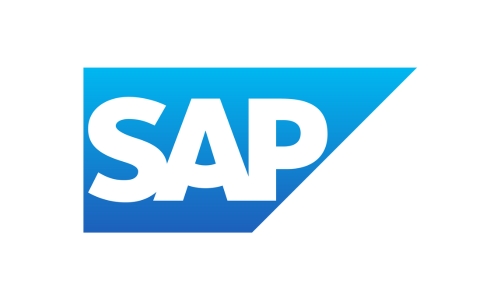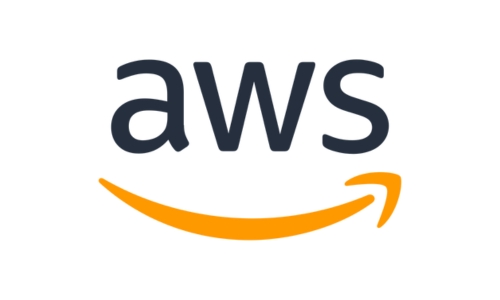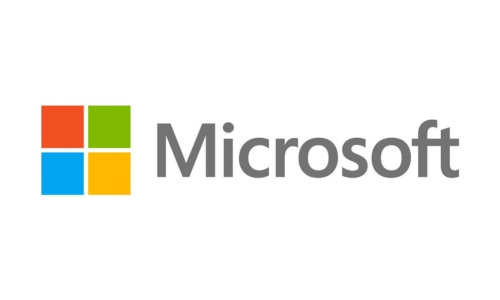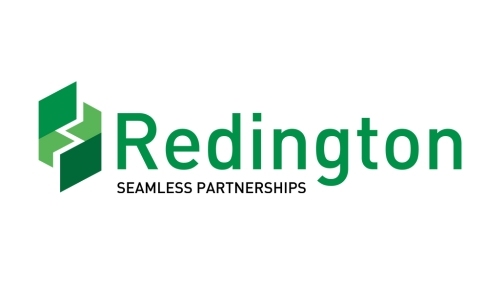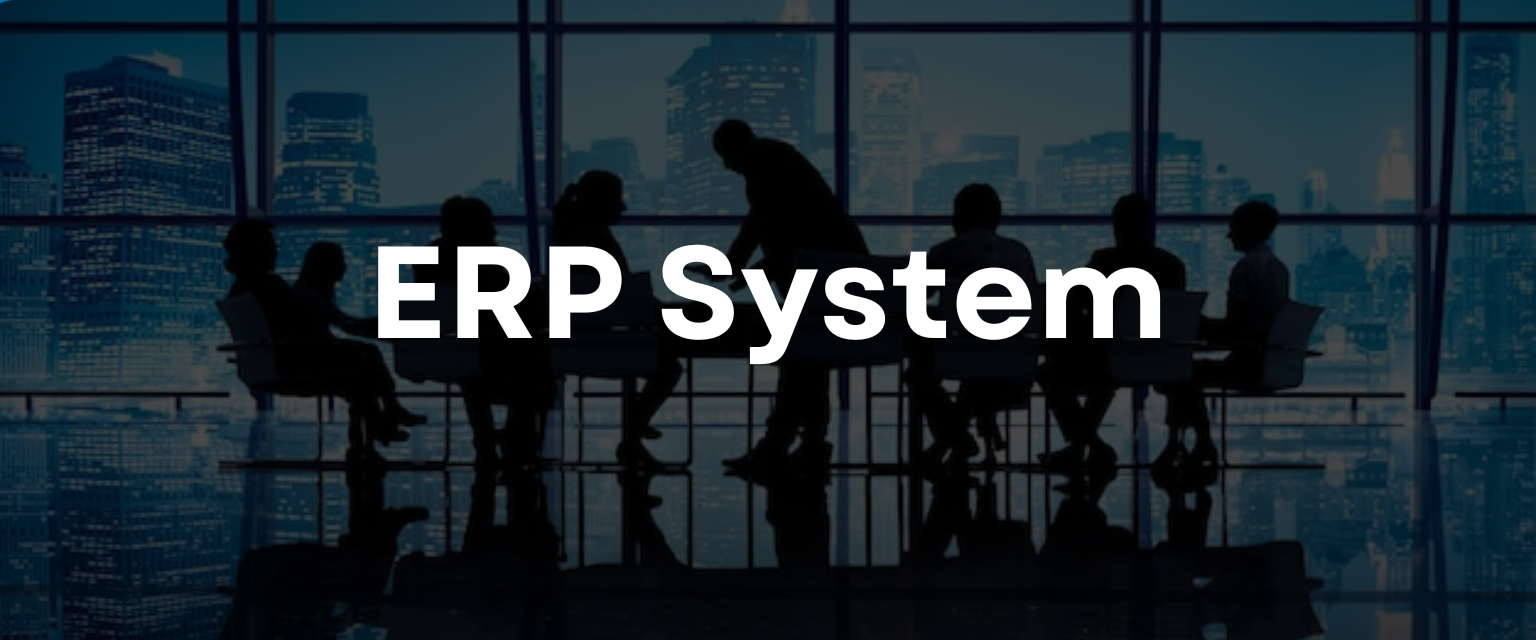Running a business in 2025 without an ERP system is like driving a car without a GPS—you might reach your destination, but it’ll take longer, cost more, and cause unnecessary stress. In today’s fast-moving world, businesses need a system that connects everything sales, inventory, finances, and operations into one easy-to-use platform.
An ERP (Enterprise Resource Planning) system does exactly that. It helps businesses work smarter, not harder, by automating tasks, reducing errors, and improving decision-making. Whether you’re a small startup or a large corporation, an ERP system can save you time, money, and headaches.
Let’s explore why every business needs an ERP system in 2025 and how it can take your company to the next level.
What is an ERP System?
An ERP (Enterprise Resource Planning) system is an all-in-one software solution that helps businesses manage and automate their core processes—finance, supply chain, HR, inventory, sales, and more. Instead of using different software for each department, an ERP system integrates everything into one platform, making operations smoother and data more accessible.
With businesses becoming more digital in 2025, ERP systems are smarter than ever. They use AI, cloud computing, and automation to boost productivity, reduce costs, and improve decision-making.
Top ERP Systems in 2025
If you’re considering an ERP system, here are some of the best options available in 2025
- SAP S/4HANA : A powerful cloud-based ERP known for AI-driven analytics and automation. Ideal for large enterprises
- Oracl NetSuite : A popular choice for growing businesses, offering financial management, CRM, and e-commerce integration.
- Microsoft Dynamics 365 : Great for mid-sized and large businesses, with AI-powered insights and seamless Microsoft integration.
- Odoo : An affordable open-source ERP that’s customizable and perfect for small to medium businesses.
- Infor CloudSuite : Best for manufacturing and supply chain businesses, offering industry-specific solutions.
- Acumatica : A cloud-based ERP designed for small and mid-sized businesses, offering flexible pricing.
- Workday : Ideal for HR and finance-focused organizations, with real-time analytics and automation.
History of ERP- How It All Started
The journey of Enterprise Resource Planning (ERP) started long before businesses relied on digital tools. The idea of integrating business processes came from the need to manage resources efficiently, reduce waste, and improve productivity.
Why Was ERP Created?
Before ERP, companies used separate systems to manage different functions—one for accounting, another for inventory, and another for HR. This led to data silos, inefficiencies, and human errors. Businesses needed a centralized system that could connect all departments and provide real-time data to improve decision-making.
When Was ERP Created?
The roots of ERP trace back to the 1960s, when manufacturing companies used Material Requirements Planning (MRP) systems to track inventory and production schedules. Over time, these systems evolved into Manufacturing Resource Planning (MRP II) in the 1980s, which included more features like finance and HR management.
The term “ERP” was officially coined in 1990 by Gartner, a leading research firm, when software solutions expanded beyond manufacturing and started integrating finance, HR, supply chain, and customer management.
Who Created ERP?
Many companies contributed to the development of ERP, but some key pioneers include:
- IBM (1960s) – Developed the first large-scale computerized business systems.
- J.I. Case & IBM (1970s) – Created an early MRP system that laid the foundation for ERP.
- SAP (1972, Germany) – Founded by five former IBM engineers (Dietmar Hopp, Hasso Plattner, Claus Wellenreuther, Klaus Tschira, and Hans-Werner Hector), SAP introduced SAP R/1, one of the first real ERP systems.
- Oracle (1977, USA) – Founded by Larry Ellison, Bob Miner, and Ed Oates, Oracle developed database management systems that later evolved into ERP solutions.
- Baan Corporation (1980s, Netherlands) – A major player in ERP history, offering advanced software for manufacturing industries.
- Microsoft & PeopleSoft (1990s-2000s) – These companies entered the ERP market, making it more accessible to mid-sized businesses.
How ERP Solves Real Business Problems
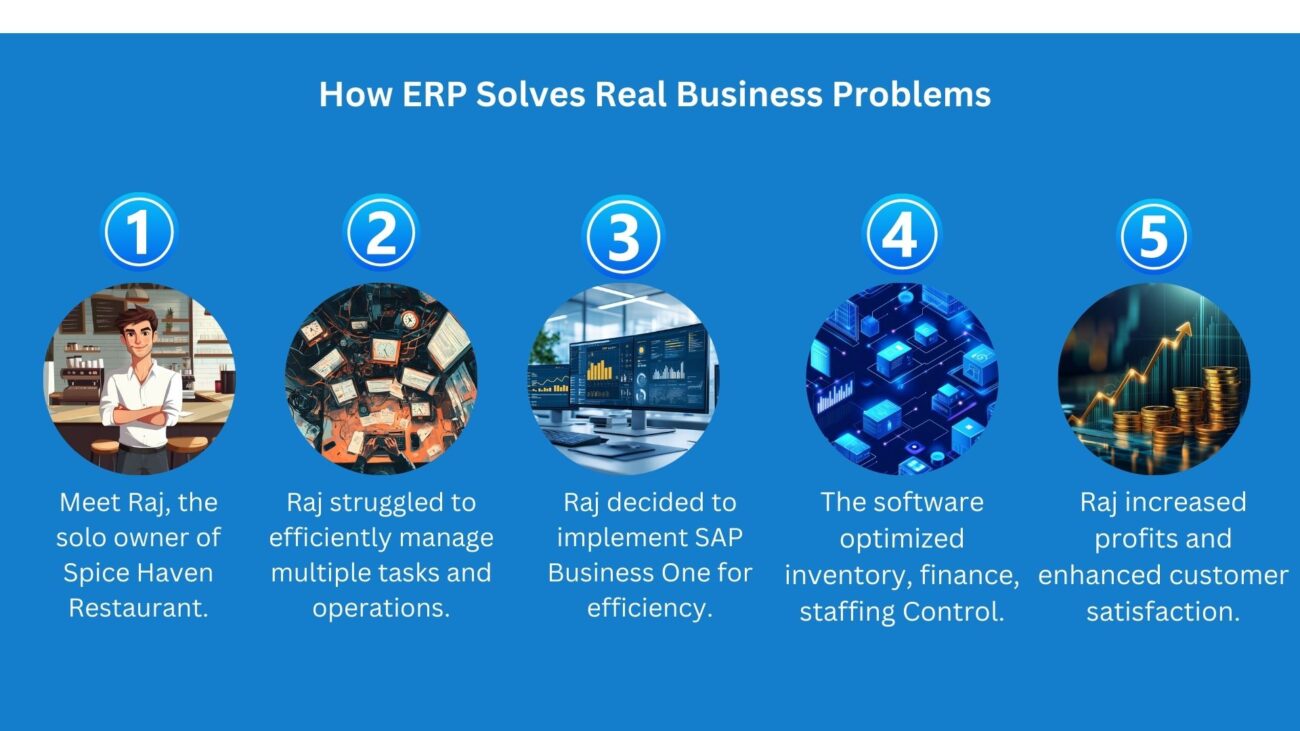
Meet Raj, the owner of Spice Haven, a popular Indian restaurant chain. With three locations in Toronto and plans for more, Raj was excited about his business growth. But behind the scenes, he was struggling to manage everything efficiently.
The Daily Challenges
Raj faced several issues that kept him awake at night:
Inventory Mismanagement: Ingredients would either run out too soon or sit unused, leading to waste.
Financial Tracking Issues: With numbers scattered across spreadsheets, it was hard to keep track of cash flow and profits.
Employee Scheduling Confusion: Shift planning was messy, leading to either too many or too few staff members during peak hours.
Customer Service Problems: Orders were delayed due to kitchen miscommunication, leading to negative reviews.
After struggling with inefficiencies for months, Raj knew he needed a smarter way to manage his restaurant chain. That’s when he decided to implement SAP Business One, a cloud-based ERP system designed for growing businesses.
Here’s how SAP Business One transformed Spice Haven:
✅ Real-Time Inventory Management – The system tracked ingredient levels across all locations and automatically reordered supplies before they ran out. No more last-minute shortages of essential items like basmati rice or butter chicken sauce.
✅ Integrated Financial Management – With SAP’s real-time financial reporting, Raj could see daily sales, expenses, and profit margins at a glance. Instead of waiting for accountants to compile reports, he had instant insights into his cash flow.
✅ Optimized Employee Scheduling – Using SAP’s workforce management tools, Raj could schedule shifts based on customer demand, ensuring the right number of staff was available during peak hours while reducing labor costs on slower days.
✅ Seamless Order Processing – The SAP ERP system connected the POS (Point of Sale) system with the kitchen, ensuring accurate and timely order fulfillment. This eliminated miscommunication and sped up service, leading to happier customers.
✅ Multi-Location Control – With SAP Business One’s centralized dashboard, Raj could manage all three locations from one place, compare sales performance, and make data-driven decisions for expansion.
The Results?
Within six months, Spice Haven saw:
📈 30% increase in profits
📉 40% reduction in food waste
⭐ Higher customer satisfaction and better online reviews
What Industries Use ERP Systems the Most?
ERP systems are designed to improve efficiency, automate processes, and provide real-time insights across industries. While almost any business can benefit from ERP, some industries rely on it more than others due to their complex operations.
Here are the top industries that use ERP the most:
Manufacturing
- Why? Tracks raw materials, production schedules, inventory, and supply chain.
- ERP Benefits: Reduces waste, automates production planning, and ensures timely deliveries.
- Popular ERP Solutions: SAP S/4HANA, Oracle NetSuite, Infor CloudSuite, Microsoft Dynamics 365.
Retail & E-Commerce
- Why? Manages stock, sales, customer orders, and multi-channel operations.
- ERP Benefits: Enhances inventory management, automates order fulfillment, and improves customer experience.
- Popular ERP Solutions: SAP Business One, Oracle NetSuite, Shopify ERP, Microsoft Dynamics 365.
Healthcare & Pharmaceuticals
- Why? Tracks patient records, compliance, medical inventory, and billing.
- ERP Benefits: Ensures regulatory compliance, streamlines supply chain, and improves patient care.
- Popular ERP Solutions: SAP for Healthcare, Oracle Health, Epic Systems, Infor Healthcare.
Construction & Engineering
- Why? Manages projects, contracts, materials, and workforce.
- ERP Benefits: Tracks costs, schedules projects, and ensures on-time completion.
- Popular ERP Solutions: SAP S/4HANA, Acumatica, Viewpoint, Procore.
Logistics & Supply Chain
- Why? Handles warehousing, shipping, and transportation.
- ERP Benefits: Optimizes route planning, automates inventory tracking, and enhances real-time visibility.
- Popular ERP Solutions: SAP SCM, Oracle SCM Cloud, Microsoft Dynamics 365, Infor Nexus.
Education & Universities
- Why? Manages student records, finances, faculty, and learning platforms.
- ERP Benefits: Automates admissions, tracks attendance, and manages resources efficiently.
- Popular ERP Solutions: SAP Student Lifecycle Management, Oracle PeopleSoft Campus Solutions, Ellucian.
Food & Beverage Industry
- Why? Controls inventory, ensures food safety compliance, and tracks supply chain.
- ERP Benefits: Reduces food waste, streamlines procurement, and manages multi-location restaurants.
- Popular ERP Solutions: SAP Business One, Microsoft Dynamics 365, Infor M3, Oracle NetSuite.
Financial Services & Banking
- Why? Handles transactions, customer accounts, and compliance.
- ERP Benefits: Ensures regulatory compliance, automates financial reporting, and enhances security.
- Popular ERP Solutions: SAP Fioneer, Oracle Financial Services, Workday, Microsoft Dynamics 365.
Automotive Industry
- Why? Manages production, distribution, and dealership networks.
- ERP Benefits: Optimizes manufacturing, tracks vehicle inventory, and improves quality control.
- Popular ERP Solutions: SAP for Automotive, Plex Systems, Infor CloudSuite, Microsoft Dynamics 365.
Hospitality & Travel
- Why? Handles bookings, guest management, financials, and customer service.
- ERP Benefits: Automates reservations, manages hotel operations, and improves guest experience.
Popular ERP Solutions: SAP Hospitality, Oracle OPERA, Microsoft Dynamics 365.
Cloud-Based vs. On-Premise ERP: What’s the Difference?
Cloud-based ERP: Cloud-based ERP is hosted online, offering lower upfront costs, automatic updates, and remote accessibility with a subscription model. It’s ideal for businesses needing scalability and minimal IT maintenance.
On-premise ERP: On-premise ERP is installed on company servers, providing full control over data and security but requiring higher upfront investment and in-house IT management. It suits businesses with strict data compliance need
|
feature |
Cloud-Based ERP |
On-Premise ERP |
|---|---|---|
|
Cost |
Lower upfront, subscription-based |
High upfront, long-term investment |
|
Maintenance |
Vendor-managed, automatic updates |
Requires in-house IT team |
|
Security |
Vendor handles security, potential risks |
Full control over data security |
|
Accessibility |
Remote access from anywhere |
Limited to office locations |
|
Scalability |
Easily scalable |
Requires manual upgrades |
How to Choose the Right ERP System for Your Business
Selecting the right ERP system is a big decision that can impact your business efficiency, growth, and profitability. With so many options available, it’s important to choose one that fits your specific needs. Here’s a step-by-step guide to help you make the right choice
Identify Your Business Needs & Goals
Before looking at ERP options, define what you need from the system. Ask yourself:
✅ What are the biggest challenges in my business? (e.g., inventory tracking, financial management, customer relationship management)
✅ Which departments need ERP integration? (Finance, HR, Supply Chain, Sales, etc.)
✅ Do I need a solution that supports multiple locations or remote teams?
✅ What are my business growth plans in the next 3–5 years?
Choose Between Cloud-Based & On-Premise ERP
- Cloud-Based ERP: Hosted online, accessible from anywhere, lower upfront costs, automatic updates. (e.g., SAP Business One, Oracle NetSuite, Microsoft Dynamics 365)
- On-Premise ERP: Installed on your company’s servers, requires in-house IT, more secure, higher upfront costs. (e.g., SAP S/4HANA, Infor ERP, Epicor ERP)
Consider Industry-Specific ERP Solutions
Not all ERP systems are designed the same way. Some are general-purpose, while others are industry-specific.
🔹 Manufacturing: SAP S/4HANA, Infor CloudSuite, Oracle ERP
🔹 Retail & E-Commerce: SAP Business One, Shopify ERP, Oracle NetSuite
🔹 Healthcare & Pharmaceuticals: SAP for Healthcare, Oracle Health, Infor Healthcare
🔹 Construction & Engineering: Acumatica, Viewpoint, Procore
🔹 Logistics & Supply Chain: SAP SCM, Oracle SCM Cloud, Microsoft Dynamics 365
🔹 Hospitality & Travel: SAP Hospitality, Oracle OPERA
Evaluate Key ERP Features
Make sure the ERP system includes features that match your business needs.
✅ Financial & Accounting Management – Automates invoicing, payroll, tax compliance, and cash flow tracking.
✅ Inventory & Supply Chain Management – Tracks stock levels, automates purchasing, and prevents shortages.
✅ Customer Relationship Management (CRM) – Manages customer interactions and boosts sales.
✅ Business Intelligence & Analytics – Provides real-time reports and insights for better decision-making.
✅ Scalability & Integration – Can grow with your business and integrate with other tools like e-commerce, CRM, or HR software.
✅ Mobile & Remote Access – Allows teams to access the ERP from any device, anywhere.
Check the ERP Vendor’s Reputation & Support
Not all ERP providers offer the same support, training, and service quality. Before committing, ask:
- Does the vendor offer 24/7 customer support?
- Is there training available for your team?
- How often are updates & security patches released?
- Does the vendor have good reviews and case studies?
Consider Implementation Time & Cost
ERP implementation can take weeks or months, depending on the system’s complexity. Look for an option that balances cost, setup time, and customization.
💰 Cost Breakdown to Consider:
- Software License / Subscription Fees (Cloud ERP = monthly, On-Premise = one-time)
- Customization & Development Costs (For industry-specific tweaks)
- Training & User Adoption Costs
- Ongoing Maintenance & Support Fees
Test the ERP Before Buying
Many ERP providers offer free trials or demos. Always test the system before making a final decision.
✅ Request a live demo from the vendor.
✅ Try a free trial version (if available).
✅ Involve key employees who will use the ERP daily.
Cost of ERP System
The cost of an ERP system varies based on factors like business size, deployment type (Cloud vs. On-Premise), number of users, customization, and implementation services. Below is a general pricing guide to help businesses estimate ERP costs.
|
Business Size |
ERP Type |
Pricing Model |
Estimated Cost (2025) |
|---|---|---|---|
|
Small Business (1-50 employees) |
Cloud-Based |
Subscription (SaaS) |
$50 - $500 per user/month |
|
Small Business |
On-Premise |
One-Time License |
$5,000 - $50,000 (plus maintenance) |
|
Medium Business (50-500 employees) |
Cloud-Based |
Subscription (SaaS) |
$500 - $1,500 per user/month |
|
Medium Business |
On-Premise |
One-Time License |
$50,000 - $250,000 (plus customization) |
|
Large Enterprise (500+ employees) |
Cloud-Based |
Subscription (SaaS) |
$1,500+ per user/month |
|
Large Enterprise |
On-Premise |
One-Time License |
$250,000 - $5 million+ |
Additional ERP Cost Factors
|
Cost Component |
Description |
Estimated Cost |
|---|---|---|
|
Implementation & Setup |
Customization, data migration, training |
$10,000 - $500,000 |
|
Customization & Add-ons |
Industry-specific features or integrations |
$5,000 - $100,000 |
|
Training & User Adoption |
Employee training & workshops |
1,000 - $50,000 |
|
Annual Maintenance & Support |
Updates, security patches, customer support |
15-20% of license cost
|
|
Hardware & Infrastructure (For On-Premise) |
Servers, networking, IT staff |
$10,000 - $500,000 |
FAQs
What is an ERP system?
An Enterprise Resource Planning (ERP) system is software that integrates core business functions like finance, inventory, HR, and supply chain into one platform.
How does an ERP system benefit my business?
ERP improves efficiency, automates tasks, reduces errors, enhances reporting, and provides real-time insights for better decision-making.
What’s the difference between cloud-based and on-premise ERP?
Cloud ERP is hosted online with a subscription model, while on-premise ERP is installed on your company’s servers with a one-time license fee.
How much does an ERP system cost?
Costs vary from $50 to $1,500 per user/month for cloud ERP and $5,000 to $5 million+ for on-premise ERP, depending on business size and features.
How long does it take to implement an ERP system?
Implementation can take anywhere from a few weeks to several months, depending on business complexity and customization need.

Jewel Susan Mathew
Experienced SAP specialist and content writer, helping CXOs and leaders drive digital transformation with SAP solutions like S/4HANA, Ariba, Business One, and SuccessFactors.
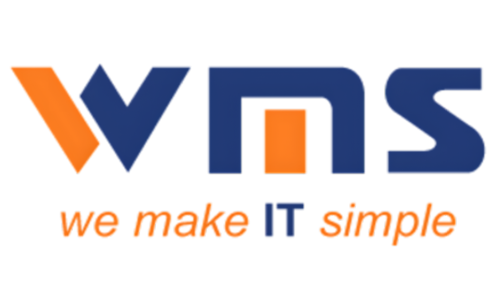
 SAP Cloud ERP Private
SAP Cloud ERP Private SAP Cloud ERP
SAP Cloud ERP SAP Business One
SAP Business One SAP Business ByDesign
SAP Business ByDesign SAP SuccessFactors
SAP SuccessFactors SAP Ariba
SAP Ariba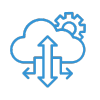 SAP Sales Cloud
SAP Sales Cloud SAP Concur
SAP Concur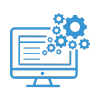 SAP Business Technology Platform
SAP Business Technology Platform SAP Analytics Cloud
SAP Analytics Cloud SAP Signavio
SAP Signavio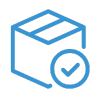 SAP Business One FASHION
SAP Business One FASHION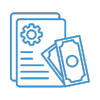 SAP Business One PAYROLL
SAP Business One PAYROLL SAP Business One PDC
SAP Business One PDC SAP Business One PDT
SAP Business One PDT SAP Business One REAL ESTATE
SAP Business One REAL ESTATE SAP Business One RENTAL
SAP Business One RENTAL